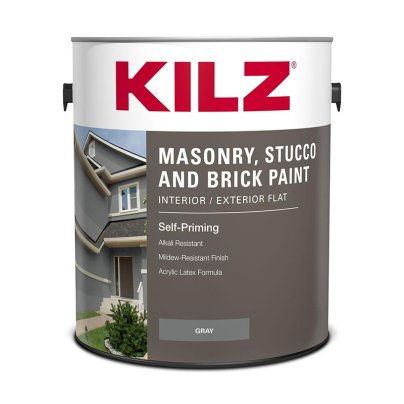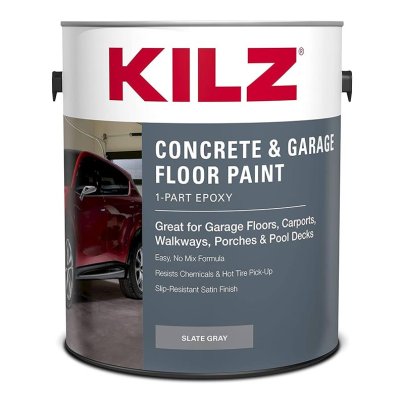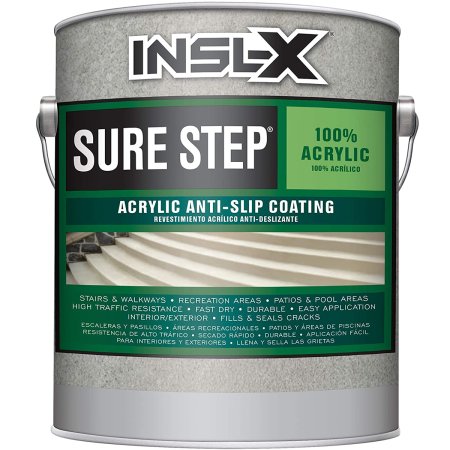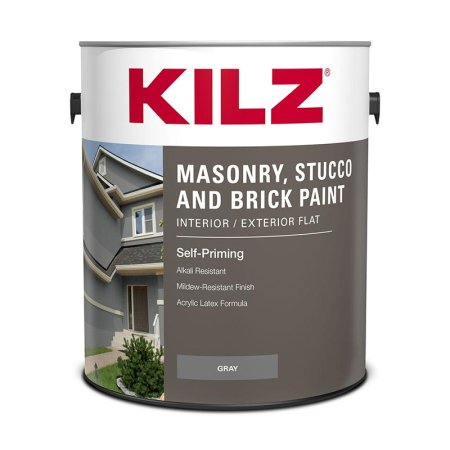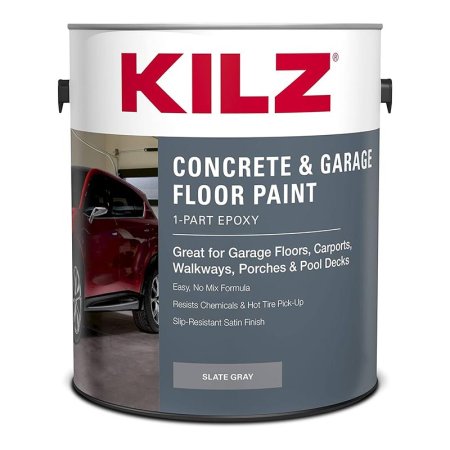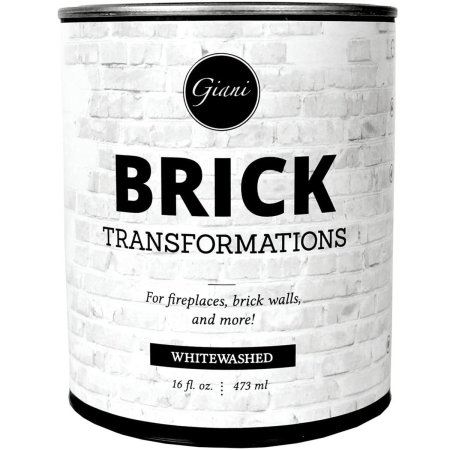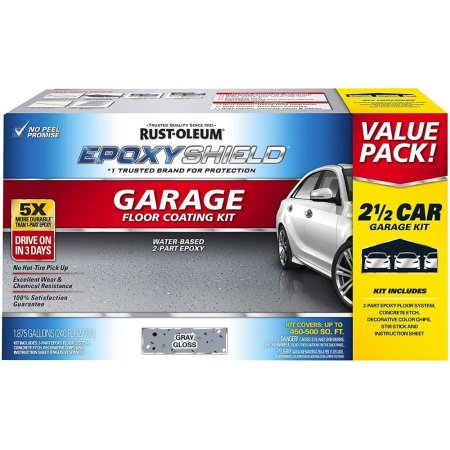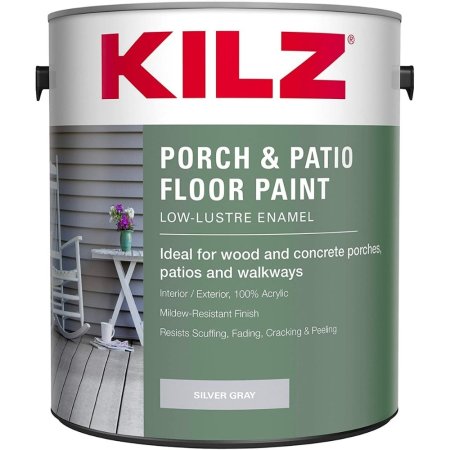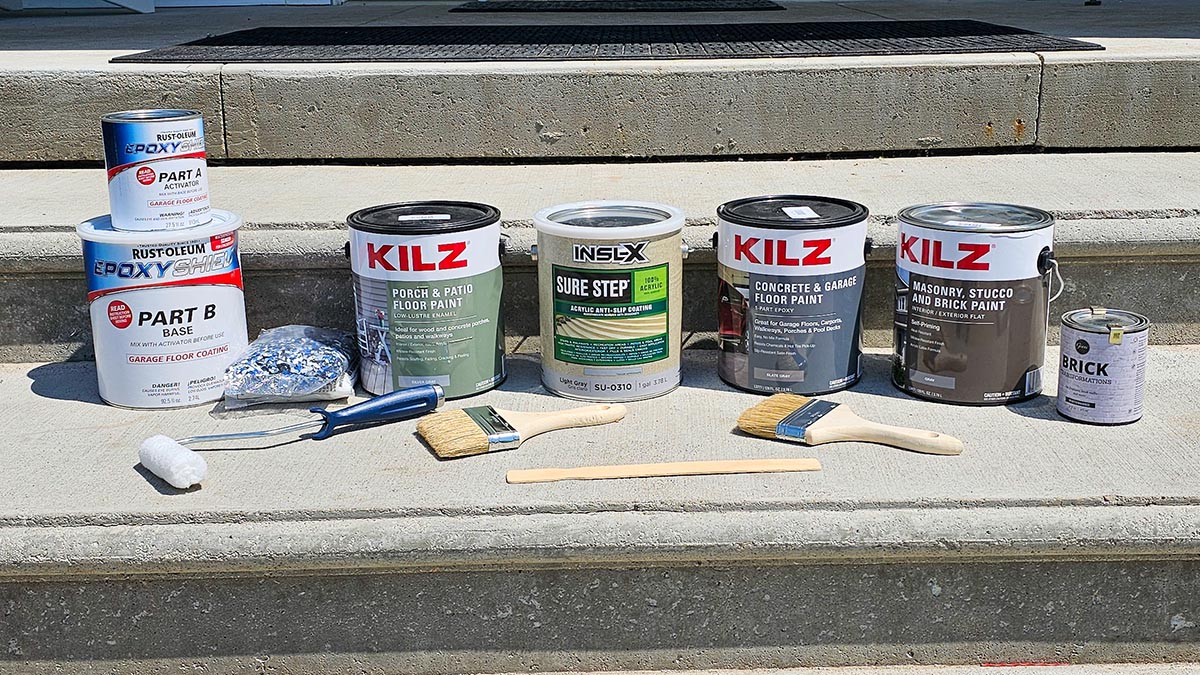
We may earn revenue from the products available on this page and participate in affiliate programs. Learn More ›
Sprucing up masonry surfaces requires special concrete paint. We recently tested six best-selling masonry paints on concrete pavers to see how easily they applied and how well they protected the pavers. Our favorite is a paint made by Benjamin Moore, INSL-X Sure Step Acrylic Anti-Slip Paint, thanks to its consistent coverage, moisture resistance, and durability. Plus, it comes with anti-slip grit in the mix, making it safer for walking on the painted surface.
Ahead, learn what to look for when shopping for paint for patios, sidewalks, and other types of masonry, including brick and stucco. Find out how the following products earned a spot on this lineup of the best concrete paints via our hands-on tests.
- BEST OVERALL: INSL-X Sure Step Acrylic Anti-Slip Paint
↓ Jump to Review - BEST BANG FOR THE BUCK: Kilz Interior/Exterior Masonry, Stucco, & Brick Paint
↓ Jump to Review - BEST FOR DRIVEWAY: Kilz 1-Part Epoxy Concrete & Garage Floor Paint
↓ Jump to Review - BEST WHITEWASH: Giani Brick Transformations Whitewash Paint
↓ Jump to Review - BEST FOR GARAGE: Rust-Oleum EpoxyShield Garage Floor Coating Kit
↓ Jump to Review - BEST FOR PORCHES & DECKS: Kilz Porch & Patio Floor Paint
↓ Jump to Review
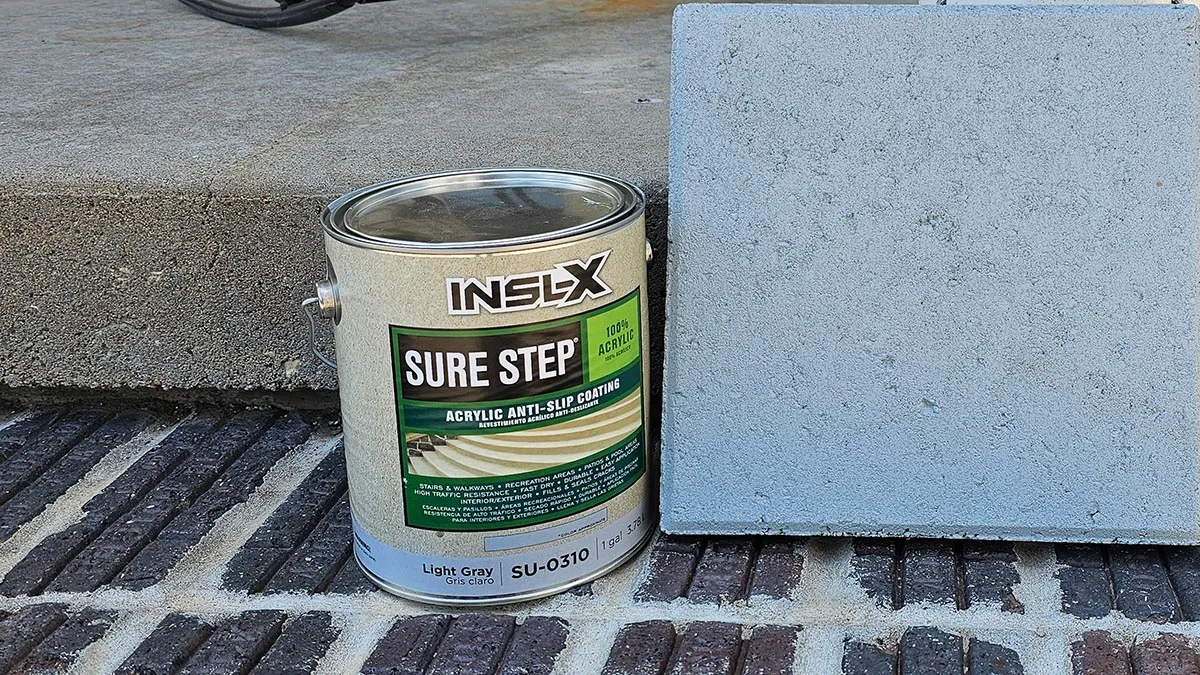
How We Tested the Best Concrete Paints
There are as many concrete paints as there are reasons for painting concrete. We considered the paint brand since manufacturers like Benjamin Moore are highly respected in the painting world. Still, we didn’t automatically exclude paints made by smaller manufacturers if they contained quality ingredients and came highly recommended by users.
In our hands-on tests, we painted masonry so we could see firsthand how the paints performed. For most of the tests, we painted clean, dry concrete pavers, but we also painted bricks to test the quality of whitewash paint. While some formulas needed just one coat, others required two.
After allowing the paints to cure for 3 weeks, we tested them for water and abrasion resistance. We awarded points based on a rubric: The better a paint performed, the more points it earned. After testing, we averaged the points to determine our top pick and categorize the paints for their best use.
| Testing Stats | |
| Products tested | 6 |
| Time spent testing | 3 weeks |
| Tests performed | 3 |
| Price range | $27 to $175 |





Our Top Picks
Choosing the best paint for concrete depends on several factors, and our list has something for nearly every scenario. Whether you’re looking for concrete wall paint or concrete floor paint, you’ll find a top performer here. Find out the pros and cons we discovered in our tests.
Best Overall
INSL-X Sure Step Acrylic Anti-Slip Paint
Product Specs
- Type: Acrylic
- Recommended coats: 2
- Finish: Matte
- Coverage area: 80 to 120 square feet per gallon
Our Ratings: Application 5/5; Coverage 4.8/5; Durability 4.3/5; Odor 5/5; Value 4.8/5
What We Like
- Anti-slip, water-based formula adds some safety to walkways
- Light foot traffic allowed after 24 hours—no waiting days to use
- Interior or exterior concrete paint is also suitable for metal and wood
What We Don’t Like
- Not suitable for damp concrete; surface must be completely dry
Finding a concrete patio paint in a color you like can be tough, but INSL-X Sure Step comes in six colors, plus white. This acrylic paint is suitable for both interior and exterior applications. While you can use it on walls, it comes with nonslip grit designed to keep floors from becoming slippery.
We applied two coats of Sure Step to our concrete pavers, and it dried to a durable, uniform finish that withstood power-washing and abrasion testing. Our testing period was 3 weeks, so we can’t promise it will last for years, but it came through our tests unscathed, and we wouldn’t hesitate to use it on our own concrete patio.
The nonslip aspect sold us on this floor paint for concrete. A regular floor enamel can become hazardous when wet, but Sure Step’s built-in traction makes it an excellent choice for pool decks and other walkways. Because this concrete coating is water-based, cleanup was easy with soap and warm water.
Read our full review: INSL-X Sure Step Acrylic Anti-Slip Paint
Get the INSL-X concrete paint at Amazon or The Home Depot.
Best Bang for the Buck
Kilz Interior/Exterior Masonry, Stucco, & Brick Paint
Product Specs
- Type: Acrylic
- Recommended coats: 1 or 2
- Finish: Flat
- Coverage area: 250 to 400 square feet
Our Ratings: Application 5/5; Coverage 4.8/5; Durability 4.3/5; Odor 5/5; Value 4.5/5
What We Like
- Budget-friendly indoor or outdoor paint for concrete, bricks, drywall, and stucco
- Mold- and mildew-resistant finish helps protect masonry
- Versatile application: paint with a brush, roller, or sprayer
What We Don’t Like
- Not made for use on concrete floors as it will not withstand foot traffic
Concrete painting doesn’t have to be a pricey project. This affordable Kilz paint provides a mold- and mildew-resistant finish well suited to damp basements, all at a great price.
We used a brush to apply the paint to our concrete pavers. The first coat seemed slightly scant, so we applied another, as Kilz recommends a second coat if desired. The finished concrete surface looked uniform, smooth, and free from brushstrokes.
This paint can be used on horizontal and vertical surfaces, but it’s not meant for floors or walkways. After the paint was cured, we washed the paver with water and scrubbed it with a nylon brush to test its water and abrasion resistance. The paint held firm.
Get the Kilz interior/exterior concrete paint at Walmart.
Best for Driveway
Kilz 1-Part Epoxy Concrete & Garage Floor Paint
Product Specs
- Type: 1-part epoxy
- Recommended coats: 1 or 2
- Finish: Satin
- Coverage area: 300 to 500 square feet
Our Ratings: Application 4/5; Coverage 4.8/5; Durability 5/5; Odor 4/5; Value 4/5
What We Like
- Although labeled an epoxy, the product comes premixed
- Durable enough to withstand car tires when dried
- Relatively low volatile organic compounds (VOCs); only a mild odor that quickly dissipates
What We Don’t Like
- Not suitable for painting walls or other vertical surfaces
This concrete floor paint from Kilz applies as easily as latex paint (no mixing here) but has the high-durability characteristics of an epoxy product.
We applied the paint using a roller since brushing it on isn’t recommended. It dried to the touch in 2 hours, and we applied a second coat after 4 hours, though the thick formula went a long way. It withstood both water and abrasion resistance testing.
Kilz specifically states that this product is not for vertical surfaces, so don’t buy it if you want to paint basement walls. But, if you’re looking for a heavy-duty concrete floor paint without the hassle of mixing two-part epoxy, this Kilz product might be just the ticket.
Get the Kilz one-part epoxy concrete paint at Lowe’s or Walmart.
Best Whitewash
Giani Brick Transformations Whitewash Paint
Product Specs
- Type: Acrylic
- Recommended coats: 1
- Finish: Whitewash
- Coverage area: 100 square feet/pint
Our Ratings: Application 4.8/5; Coverage 5/5; Durability 4/5; Odor 4.5/5; Value 4/5
What We Like
- Water-based formula is low VOC and cleans up with soap and water
- Applies with a brush or roller; users can wipe for a custom look
- Safe to use indoors and out to update brick and concrete
What We Don’t Like
- On the pricey side compared to other masonry paints, but it goes a long way
If you’re upgrading an old brick fireplace, you might like the Giani Brick Transformations whitewash paint. This acrylic water-based product is a sheer paint for cement and brick, but it’s most commonly used on brick because the fresh look tones down red and brown brick colors. It’s a cross between a paint and a concrete stain.
Giani suggests diluting the paint to get the right look. We used a paint brush to apply a 1:2 ratio of water to paint and then used a rag to wipe off the excess. This gave the bricks an updated look while allowing some of their natural red hue to show through.
This is an interior-grade paint, so we modified our water and abrasion resistance tests to mimic what the paint might face from regular cleaning. We brushed the surface of the dry bricks with a stiff nylon brush, then spritzed water on them and wiped them down. The paint stayed put on the bricks—none came off our rag. As a final test, we sanded some whitewashed brick to see if we could remove the paint. Some of the paint came off, but as far as typical cleaning goes, the Giana whitewash paint held up well.
Get the Giani concrete paint at Amazon or The Home Depot (complete kit).
Best for Garage
Rust-Oleum EpoxyShield Garage Floor Coating Kit
Product Specs
- Type: Epoxy
- Recommended coats: 1
- Finish: Glossy
- Coverage area: Up to 500 square feet (2.5 car kit)
Our Ratings: Application 4.5/5; Coverage 5/5; Durability 5/5; Odor 4/5; Value 4.3/5
What We Like
- Very durable against gas, salt, tire, oil stains, and more
- Comes in 3 colors; added options of traction grit and decorative chips
- Both parts of epoxy are premeasured—just pour one into the other and stir
- Serves as a concrete resurfacer that improves the finish and protects
What We Don’t Like
- Users must keep a wet edge when applying this product to prevent lap marks
Rust-Oleum’s EpoxyShield garage floor coating kit is a high-quality, two-part epoxy kit with everything you need to coat your garage floor with a tough and attractive finish. This traditional epoxy requires thorough mixing, but it’s very durable when it cures.
We applied EpoxyShield with a brush—one coat is all we needed. Rust-Oleum simplifies the process by instructing the user to pour the contents of Part 2 directly into the Part 1 can, so no measuring is required.
It’s vital to apply the product to clean, dry concrete so that the paint forms a strong bond. The instructions explain how to test the concrete for moisture; if it’s present, you’ll want to apply a moisture-stop product before painting.
EpoxyShield aced our water and abrasion resistance tests. The kit comes with optional decorative paint chips and traction grit, but we think the finished surface would be pretty slippery without the grit. The paint chips add some much-appreciated visual interest. Applying EpoxyShield is a bigger project than just rolling on paint, but it’s a great option if you’re looking to update a garage floor.
Get the Rust-Oleum concrete paint at Amazon, Lowe’s, or The Home Depot.
Best for Porches & Decks
Kilz Porch & Patio Floor Paint
Product Specs
- Type: Latex enamel
- Recommended coats: 2
- Finish: Low-luster
- Coverage area: 200 to 400 square feet
Our Ratings: Application 4.8/5; Coverage 4.5/5; Durability 4.3/5; Odor 4/5; Value 4.3/5
What We Like
- Easy to apply with a paint brush or a roller; suitable for interior or exterior
- Protects surface against mildew, scuffing, fading, cracking, and more
- Works on concrete, masonry, wood, and metal to form a protective shield
What We Don’t Like
- Not heavy-duty enough to withstand vehicle traffic
Check out Kilz porch and patio floor paint if you’re looking for a product that applies easily over painted surfaces like decks and patios. This latex enamel resists mildew and creates an attractive finish.
We applied two coats of paint to our concrete pavers. We painted two pavers because the manufacturer suggested allowing up to 4 weeks before washing. If the paint didn’t hold up to cleaning at our 3-week test, we wanted an additional paver to retest at 4 weeks. But it impressed us in both our moisture resistance and abrasion resistance tests.
One slight downside is that this enamel was pretty slippery when wet. For that reason, we wouldn’t apply it to a pool deck.
A 1-gallon can of Kilz floor paint can cover as much as 400 square feet with an attractive, durable finish. It self-levels into a uniform surface without any visible brushstrokes.
Get the Kilz porch and patio concrete paint at Amazon, Lowe’s, or Walmart.
Jump to Our Top Picks
What to Consider When Choosing a Concrete Paint
The following are important considerations to keep in mind when shopping for a concrete coating.
Intended Use
While several concrete paints are “interior/exterior,” others aren’t. If you want to use the paint outside, ensure it’s labeled as outdoor concrete paint. Likewise, some paints don’t work well on vertical surfaces, and others are not intended for floors. Be sure to choose a paint suitable for your project.
Weather Resistance
Good paint for outdoor concrete should withstand the elements all year round. Choose paint with weather resistance instead of letting Mother Nature have her way with your concrete surfaces. While no paint will last forever in harsh conditions, exterior-grade paints and epoxies hold up longer and require fewer repairs between coats.
Color Tone
Consider color when choosing the best concrete paint for your project. While colors like “slate” and “battleship gray” are the most common concrete paint colors, a few products offer more hues. For unique colors and effects, you might consider epoxy paint. Some have base tones and color flakes that you can scatter on the surface to change the look of your floor.
Gloss
Glossy surfaces reflect light and create a smooth, durable, and easy-to-clean surface. A shiny finish also reduces the likelihood of noticing scratches and scuffs. Epoxy surfaces are naturally glossy; you can often buff them with a floor buffer if they become dull.
One thing to remember about glossy paints is that they can be slippery, as moisture won’t absorb as easily. If you choose a glossy paint for a floor, ensure it’s nonslip.
Washability
When cleaning up messes on painted surfaces, soap and water work on both latex and epoxy floors, but epoxy withstands regular cleaning much better than latex. While latex paint will begin to break down after being washed multiple times, you can mop epoxy floors without damaging the finish.
Longevity
Latex paint applied to an average floor lasts around 2 years before another coat is needed, but on walls, it can last longer. Epoxy floor paint lasts much longer, making it the better choice for a floor with a low-maintenance finish.
Types of Concrete Paint
Familiarize yourself with the most common types of concrete paint so you can get the right concrete paint for your project.
Acrylic Latex Paint
Acrylic latex paint is a water-based product that spreads easily on masonry surfaces. It doesn’t take any special tools, brushes, or rollers; it’s a very straightforward DIY product.
Acrylic latex is budget-friendly compared to epoxy but less durable. A concrete garage floor could require a new coat of acrylic paint every 2 to 3 years, though it will last longer on vertical surfaces. Some formulas have small particles mixed throughout the paint to create a nonslip surface, ideal for walkways, steps, and floors.
Epoxy Paint
Epoxy paint is great for painting outdoor concrete surfaces. It’s an extremely durable, long-lasting cement sealer paint that can take harsh treatment, making it ideal for garage floors. Epoxies can create shiny, glossy surfaces with decorative color flakes, making them a popular choice in high-end residential garages and vehicle showrooms.
They’re more expensive than latex and can be challenging to apply, depending on the thickness and the concrete’s porosity. Still, the result is a rock-solid floor covering impervious to water and resistant to stains.
FAQs
We’ve answered some frequently asked questions about concrete paint to give you some guidance as you shop. If you don’t find your answer here, contact your paint manufacturer’s customer service department.
Some concrete epoxies are waterproof, but most concrete paints meant for exterior use are water-resistant, though they will wear down over time.
Concrete paint can be dry to the touch in as little as an hour but could take up to 24 hours to completely dry.
You can remove concrete paint with a paint stripper and a pressure washer.
Latex paints can last around 2 years before needing a fresh coat. Epoxies can last much longer, especially if you go the extra mile and maintain them with regular waxing and buffing.
It depends on the product and the existing surface. Some paints are self-priming, while others require a primer to be applied before painting concrete.
Meet the Tester
Glenda Taylor is a product tester and writer specializing in the construction, remodeling, and real estate industries. She and her husband own a general contracting company, and Taylor is experienced in residential and commercial building applications. She tests a wide range of power tools and other home improvement, household, and lawn-and-garden products.
Additional research provided by Tom Scalisi.

